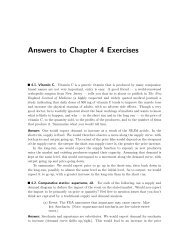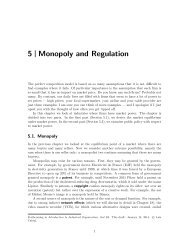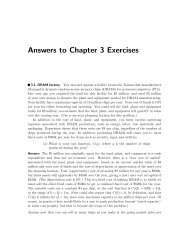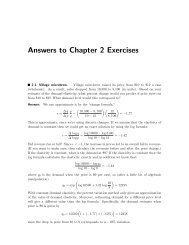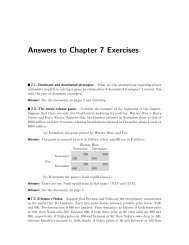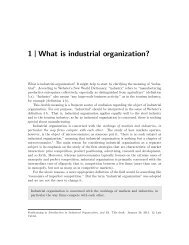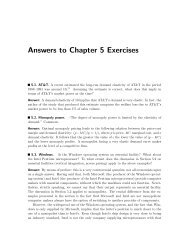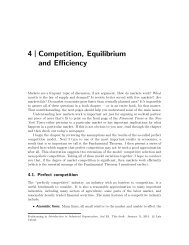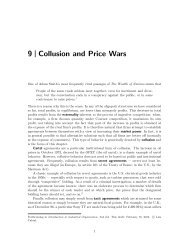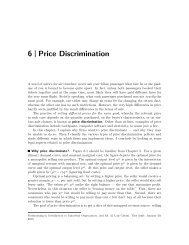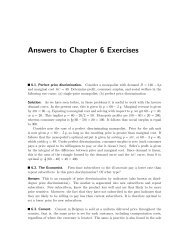8 Oligopoly - Luiscabral.net
8 Oligopoly - Luiscabral.net
8 Oligopoly - Luiscabral.net
Create successful ePaper yourself
Turn your PDF publications into a flip-book with our unique Google optimized e-Paper software.
where c is marginal cost. Let Firms 1 and 2 marginal cost now be given by c 1 and c 2 ,<br />
respectively. The two best response mappings are then given by<br />
q ∗ 1(q 2 ) = a − c 1<br />
2 b<br />
q ∗ 2(q 1 ) = a − c 2<br />
2 b<br />
− q 2<br />
2<br />
− q 1<br />
2<br />
Substituting the first equation for q 1 in the second and imposing the equilibrium condition<br />
q 2 = q2(q ∗ 1 ), we get<br />
q 2 = a − c a−c 1<br />
2 2 b<br />
− q2 2<br />
−<br />
2 b 2<br />
Solving for q 2 , we get<br />
̂q 2 = a − 2 c 2 + c 1<br />
3 b<br />
Likewise,<br />
̂q 1 = a − 2 c 1 + c 2<br />
(3)<br />
3 b<br />
(The latter expression is obtained by symmetry; all we have to do is to interchange the<br />
subscripts 1 and 2.) Total quantity is given by<br />
̂Q = ̂q 1 + ̂q 2 = 2 a − c 1 − c 2<br />
3 b<br />
Finally, Firm 1’s market share. s 1 , is given by<br />
(4)<br />
s 1 = q 1<br />
q 1 + q 2<br />
= a − 2 c 1 + c 2<br />
2 a − c 1 − c 2<br />
(5)<br />
It can be showed that s 1 > s 2 if and only if c 1 < c 2 . (Can you do it?) It follows that,<br />
by decreasing its cost below its rival, the Japanese firm’s market share is greater than the<br />
American’s.<br />
Calibration. I would like to go beyond the expression on the right-hand side of (5) and put<br />
an actual number to the value of s 1 . So far, all I know is that, initially, c 1 = c 2 , whereas,<br />
after the devaluation, c 2 remains constant at $12, whereas c 1 drops to 12/1.5 = $8. As<br />
can be seen from (5), in order to derive the numerical value of s 1 , I need to obtain the<br />
value of a. The process of obtaining specific values for the model parameters based on<br />
observable information about the equilibrium is know as model calibration.<br />
Earlier, I determined that, in a symmetric Cournot duopoly,<br />
p = a + 2 c<br />
3<br />
where c is the value of marginal cost. Solving with respect to a and plugging in the values<br />
observed in the initial equilibrium, I get<br />
a = 3 p − 2 c = 3 × 24 − 2 × 12 = 48<br />
Given this value of a and given c 1 = 8 and c 2 = 12, I can now use (5) to compute the<br />
Japanese firm’s market share:<br />
s 1 =<br />
48 − 2 × 8 + 12<br />
2 × 48 − 8 − 12 ≈ 58%<br />
In summary, a 50% devaluation of the Yen increases the Japanese firm’s market share to<br />
58% from an initial 50%.




